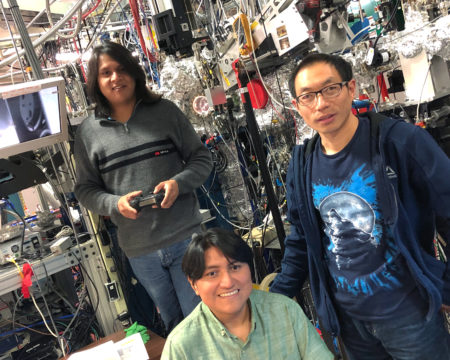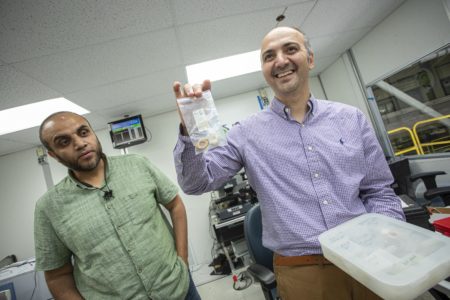by Cindy Lee
As light sources push the limits of research and innovation, it’s important not to leave any regions in the dark. One effort to increase access to these rare and complex facilities is LAAAMP—Lightsources for Africa, the Americas, Asia and Middle East Project. Through LAAAMP, researchers in regions without synchrotrons gain hands-on experience and are connected with the expertise at established light sources. This year, teams from Mexico and Egypt came to the Advanced Light Source (ALS) for two months through LAAAMP to study solar cells and mummies.
Soft x-rays illuminate solar cell research
Julio Villanueva-Cab and Alfredo Romero-Contreras of Benemérita Universidad Autónoma de Puebla in Mexico are truly harnessing light—they came to the ALS to work on plasmonic dye-sensitized solar cells with Staff Scientist Wanli Yang. “There has been a lot of theoretical and experimental work on the structural properties of the titanium oxide semiconductor,” Villanueva-Cab said, “but nothing has been proven experimentally in the device.” At the ALS, they tried to establish the relationship between structural and electronic properties of the devices. “People believed that putting metallic nanoparticles into the semiconductor matrix doesn’t change anything structurally,” Villanueva-Cab said, “but we were able to prove that that is not true.” They returned to the ALS this summer to extend their project from last year.


In solar cells, photons “charge” materials by exciting their electrons. The soft x-ray capabilities at Beamline 8.0.1 allowed the researchers to directly see electron states, a critical part of a material’s performance. Unlike common solar cells with bulk solid material, Villanueva-Cab explained, “these are nanostructured materials that have more surface area, so soft x-rays are more useful.” Their titanium oxide samples contained varying percentages of gold nanoparticles, and optical absorption varied accordingly. Citing the dye molecules adsorbed onto the titanium oxide surface, he explained that the inspiration for these devices is photosynthesis in plants. Because the materials can be transparent or made with different colors, they could someday be used as window panes, cell phone screens, or in a number of other applications.
Unwrapping the secrets of mummy bones
Ahmed Elnewishy and Mohamed Kasem of the National Institute of Laser-Enhanced Science (NILES) at Cairo University in Egypt are digging into history, but unlike their archaeologist collaborators, they don’t use shovels—they use light sources. Elnewishy and Kasem obtained samples of mummy bones that are 2,000 to 4,000 years old from across Egypt and from four different dynasties: the Middle Kingdom, Second Intermediate Period, Late Period, and Greco-Roman.
Elnewishy and Kasem were eager to bring their samples to the ALS to work with Research Scientists Hans Bechtel and Eric Schaible. “The knowledge and the facilities are great,” Elnewishy said, citing the broad range of techniques, the access to customized sample preparation, and the expertise of the staff. The underlying question they’re hoping to answer is whether the conditions of the bones are due to environmental factors in the soil (diagenesis) or due to habits when the subject was alive (biogenesis). “Bones act like archives,” Kasem said, “so we have found lead, aluminum, and other elements that indicate how the environment and toxicity were at the time.”


The bone samples came from the shaft and head of the femur of the mummies. “The shaft of the femur is more resistant to degradation and diagenesis,” Elnewishy explained, in contrast to the spongy head of the femur. Using SAXS/WAXS at Beamline 7.3.3, they were able to study the collagen structure in the bones, where the molecular structure can become disorganized over time. “The collagen becomes loose and gets out of the fibers,” Kasem described. They could compare the scans from the surface of the shaft, which came into contact with the soil, with the scans in the core, where degradation would be due to biogenesis. Using FTIR at Beamline 1.4, they were able to obtain a molecular fingerprint that will allow them to compare bone from different dynasties. Their data is an important component of cultural heritage preservation, particularly in light of the highly anticipated Grand Egyptian Museum in Giza, due to open in 2020.
Light up the world
After running experiments at the ALS, the LAAAMP researchers all have ideas for future studies using a synchrotron light source. In the effort to improve efficiencies in dye sensitized solar cells, Romero-Contreras discussed an environmentally friendly option. “We want to be green, so we are trying to use water, but we don’t know the effects on the structural properties of the titanium oxide, so we need to find the answer.” He and Villanueva-Cab both hope to send more samples and return to the ALS. Elnewishy and Kasem also foresee further synchrotron-enabled research, particularly after an ALS beamline scientist suggested using modern-day bones for comparison. They will also have an opportunity to apply their experiences closer to home. “The idea is to establish a scientific community that can make use of SESAME,” Kasem said, citing the newly opened synchrotron light source in Jordan. With efforts from the ALS, researchers around the world, and organizations like LAAAMP, the global scientific community is getting brighter each day.